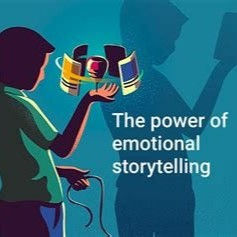The Power of Emotional Storytelling in Ads (And How to Do It Right)
- Harsh Thariani
- May 7
- 4 min read
Updated: May 10
Emotional ads make you cry or laugh, but they also make you buy. Here’s how top brands use emotional appeal—and how you can too.
Think of the last ad you saw that stuck with you. Was it a heartwarming tale of a parent and child? A funny moment that caught you off guard? Maybe it was a story that made you feel something—whether it was joy, sadness, or even anger.

Here’s the secret: Emotional storytelling is one of the most powerful tools in advertising. Brands that make you feel something—anything—are the ones that stay with you. But emotional ads aren’t just about tugging at heartstrings; they’re about creating connections that inspire action.
So, why does emotional storytelling work so well in advertising?
1. People Remember Emotions, Not FactsHumans are wired to remember experiences that stir up emotions. Studies show that we retain emotional experiences much better than factual information. That’s why ads that evoke an emotional response have a higher chance of sticking in our minds.
Think about Coca-Cola’s “Share a Coke” campaign. They didn’t just push the product—they tied it to a memory of togetherness and happiness. By using your name on a bottle, they personalized the experience. It wasn’t about the soda; it was about sharing a moment with someone you care about. And that’s the magic of emotional advertising.
2. Emotional Ads Drive ActionIt’s not just about feeling something—it’s about taking action. According to research, ads that provoke an emotional reaction (whether positive or negative) perform better in terms of ROI (return on investment) and consumer engagement. Why? Because when you tap into someone's emotions, they are more likely to act on those feelings.
Take the example of Dove’s “Real Beauty” campaign. Dove wasn’t just selling soap—they were selling self-esteem and confidence. They used real women of all shapes, sizes, and skin colors to promote their products, and it resonated deeply with audiences. The emotional connection led to a shift in how people viewed beauty, and Dove saw a direct boost in sales.
3. Fear Can Be a Powerful Emotional TriggerFear isn’t just about scaring people—it's about motivating them to take action. Fear-based ads are often used in campaigns that promote safety, health, or insurance. But here’s the trick: It’s not about exploiting fear, it’s about showing how your product or service can protect people from those fears.
Think about insurance companies like Geico, whose ads often play on humorous takes of worst-case scenarios. The idea isn’t to make you feel terrified—it’s to show that their product can prevent those terrifying situations from happening. That mix of fear with humor creates a unique emotional response that’s both memorable and effective.
4. Joy and Happiness Are Universal DriversWhile fear can motivate action, happiness and joy are universal motivators that can create a long-lasting connection with your audience. People are naturally drawn to positive emotions—especially when they align with their personal values.
Nike’s “Just Do It” campaign is a prime example. The slogan itself promotes a sense of achievement and happiness that resonates with everyone, from professional athletes to those just getting started on their fitness journey. The emotional connection makes people believe that buying Nike isn’t just about getting sports gear; it’s about feeling empowered and accomplished.
5. Nostalgia SellsNostalgia has a powerful effect on us. It brings back feelings of comfort, warmth, and familiarity. Brands tap into nostalgia to create a sense of connection and remind consumers of a simpler, happier time.
Take the “Back to the Future” McDonald’s ad where they revived the 80s Happy Meal packaging or Coca-Cola’s holiday ads that feature iconic polar bears. These ads play on nostalgia, making us feel like kids again. That emotional response drives sales by triggering fond memories of the past.
How to Use Emotional Storytelling in Your Ads:
1. Know Your Audience’s Pain PointsUnderstand the emotional drivers that affect your target audience. Are they looking for comfort? Empowerment? Safety? Once you identify these pain points, craft your message to resonate with them.
2. Use Relatable Characters and Real SituationsYour audience wants to see themselves in the stories you tell. Use real-life situations that people can relate to, whether it’s a mother’s love for her child or the joy of overcoming a challenge.
3. Be AuthenticAuthenticity is key. Your emotional story must feel genuine and aligned with your brand values. Viewers can spot a fake emotional appeal from a mile away. Stay true to who you are as a brand.
4. Keep It SimpleYou don’t need a complex plot to tug at someone’s heartstrings. Sometimes, the most powerful emotional stories are the simplest—like a single moment that makes people stop and think.
5. Trigger the Right Emotions at the Right TimeChoose the right emotional trigger for your campaign’s goals. Do you want to inspire joy? Use uplifting messages. Want to motivate action? Use urgency or fear. Each emotion has a purpose in driving a specific response.
Takeaway:Emotional storytelling in advertising is not just about making people feel—it’s about creating meaningful connections that drive action. Whether you’re evoking joy, nostalgia, fear, or happiness, the key is to tap into emotions that resonate with your audience and align with your brand. When done right, emotional storytelling can turn a simple ad into a memorable, action-driving masterpiece.




Comments